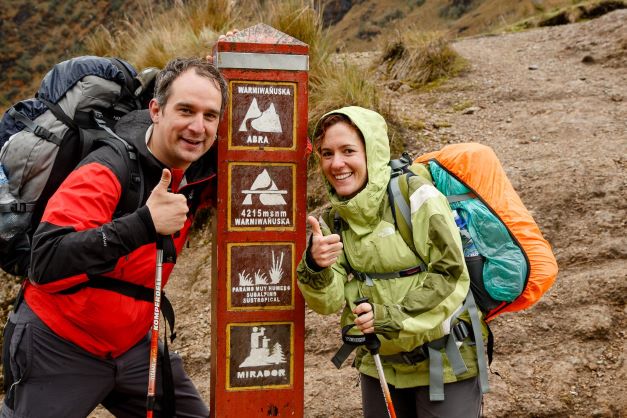Walking the Inca Trail is one of the great iconic travel experiences anyone can have today. Each year, thousands of hikers undertake the four-day journey that ends at the famous Inca ruins of Machu Picchu, which stand at an elevation of 7,972 feet above sea level. It’s a journey that challenges the spirits of those who undertake it, but also handsomely rewards them for sheer achievement.
During almost four days of hiking, the sights and attractions along the way are exciting and varied. Archaeological ruins, panoramic views, and lush forests are all linked by their common stone path, first laid down by the Incas themselves and worn through hundreds of years of ambitious steps. Of all the notable features on the trail, the most talked about is the Dead Woman’s Pass (“Warmiwañusca” in the Quechua language). This natural feature is so named because, when viewed from the valley below, its ridges resemble the shape of a woman’s supine body.
Meaning of Warmiwañusca
Warmiwañuska is a name in Quechua that means Warmi = Woman, Wañuska = Dead. It is a pass, a mountain pass and the highest point of the Inca Trail. It is located at 4,215 m. / 13,828 ft.
What is Warmiwañusca in Peru?

Warmiwañusca 
Warmiwañusca
It is a high Andean area, which is accessed after a long walk, of 4 or 5 hours, along a steep path. The landscape is covered with ichu or straw, it is surrounded by mountains with abundant flora on one side and mountains covered with snow, which are shown as a backdrop to the landscape.
From Warmiwañusca in Peru, you have a beautiful view, the panorama is impressive, because you can see in the background the landscape of the jungle, the mountains covered with snow, you have the sky closer to the earth. In the rainy season it is a very dangerous pass, it can fall unexpectedly, snow and the pass be covered with mist.
It is the most vulnerable zone, as far as climatic changes are concerned; It is the highest point of the Inca Trail to Machu Picchu, and it is the most coveted point for its splendid view.
Warmiwañusca on the Inca Trail
El Paso de la Mujer Muerta, also known as Warmiwañusca in Peru, is so named because the mountain resembles the profile of a woman looking up at the sky.
Warmiwañusca is located on the Inca Trail to Machu Picchu, southwest of the archaeological site of Patallacta. It is situated at an elevation of 4,200 meters (13,780 feet).
What makes Dead Woman’s Pass so famous (or infamous) is its altitude. At 4,215 m (13,828 ft), it is the highest (and most feared) point on the Inca Trail, and almost 1,800 m (5,905 ft) higher than the altitude of Machu Picchu. The pass arrives on the second day of the hike, often perceived as the most challenging. Because much of the day is spent at higher altitudes with fewer trees, the terrain becomes rockier and more difficult, and hikers are more exposed to the day’s weather conditions, which can offer everything from cool rains to scorching sun and strong winds.
The ascent is through a steep path, with the presence of stairs and has a length of 9 km ascent. At this point the air is a bit dense and cold, the temperature is between 5ºC and 7ºC. It is a journey that leaves most walkers breathless.
Everyone who walks the Inca Trail 4 days / 3 nights has their own experience and their favorite memories that they take home. Warmiwañusca on the Inca Trail is a great achievement for hikers, yet it is only one in a hike full of special moments. It is the embodiment of the importance of the journey, more than that of the destination.
Alternatives to the Inca Trail
The Inca Trail is one of the most famous treks in South America and the world. Due to its popularity, there is a limit of 500 people on the trail per day, including guides and porters. This means that it is often fully booked practically every day of the year and some people may not be able to reserve a spot. Others may prefer less popular but more authentic hikes away from the tourist hordes, and alternatives are available. The Salkantay Trek 5 days / 4 nights is the only other trek that ends in Machu Picchu. It is more challenging and reaches even higher altitudes than the classic Inca Trail. Other options include the beautiful Lares trek, the Choquequirao Tour 4 days / 3 nights, the Ausangate trek and the Vilcabamba Trek. Or read our article on the best treks in Peru.










